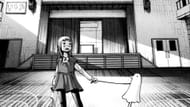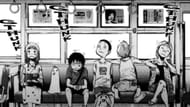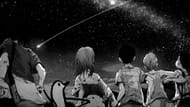Oyasumi PunPun might have ended for some years now, but due to how splendid the manga was, it still stays fresh in the minds of viewers. Many of these viewers have clamoured for an anime adaptation, but there has been no news about that from any studio.
While there are doubts from Otaku as to whether an anime adaptation of Oyasumi PunPun would receive critical acclaim, there is no doubt that it would boost the popularity of the series. An anime of Oyasumi PunPun might finally put it in the same category along with other masterpieces, especially the Seinen Big 3: Vinland Saga, Vagabond, and Berserk.
These three seinen masterpieces routinely get spoken about in popular media, and Oyasumi PunPun deserves that same dissection. A huge portion of Goodnight PunPun is psychedelic and relies more on subtle trippy cues to pass on its message; this is why the series needs to be scrutinized.
Oyasumi PunPun, at its core, is a story about the pitfalls of cynicism and nihilism. PunPun, the main character, struggles to adjust as an adult, leading to a sad life. Another aspect of the story that barely gets its day in the sun is how it captures the struggles of childhood.
Most stories tend to ignore how formative childhood and teenage years are, but Goodnight PunPun does not do that. It shines its light on the most turbulent and identity-defining moment of a person’s life—teenage years, and captures teenage angst most realistically.
It delves deeply into how the environment can contribute to this angst. This can be through relationships, accidents, and the changes occurring within their guardians. The series does not shy away from the gritty reality of things, and it gives an unfiltered portrayal of what it means to be a teenager. Keep reading to find out why Goodnight PunPun captures teen angst better than any manga.
Disclaimer: This article reflects the author’s views and may contain spoilers.
Why is teenage angst absent in most manga

To understand how Goodnight PunPun captures teen angst, one must understand what teen angst is. Teenage angst refers to the emotional and behavioral changes many teenagers face as they leave childhood behind and become full-fledged adolescents. Teenage angst, or teen angst as it is popularly called, is characterized by feelings of anxiety, depression, rebellion, and loss. These feelings are caused by hormones, stress, and a plethora of other factors.
When it comes to most forms of fiction, teenage angst has been fairly represented. Books like 13 Reasons Why, The Perks of Being a Wallflower, and Normal People have given an accurate depiction of what teen angst is; films like Call Me By Your Name, American Graffiti, and Dazed and Confused have also accurately depicted teenage angst. However, manga has not been so forthright in its depictions, or has flat-out acted like teenage angst is nonexistent.
While this is surprising as a great deal of popular anime and manga are centered on teenagers, from Naruto, Bleach, One Piece, Jujutsu Kaisen, and Chainsaw Man, most of their casts are teenagers. However, the world of this series does not give any of its teenagers any time to really confront their feelings, as they are constantly facing existential threats.
Goodnight PunPun is different, as the teenage characters are not facing constant battles. GTO is another manga that has its characters feel teenage angst, and this is due to a lack of tangible battles, so the battles the characters face are internal.
How teenage angst is depicted in Oyasumi PunPun

The main reason Oyasumi PunPun depicts teenage angst better than any series is that there is a lack of a central conflict in the series. Unlike most manga, where there is a big bad problem that the characters have to face, the problems the characters face in Oyasumi PunPun are due to the randomness of life. This is why teen angst is so rife in Goodnight PunPun, as it is caused by factors beyond the teenage characters' control.
When Oyasumi PunPun shows its characters experiencing teenage angst, no two characters experience the same feelings, as each character has a different battle they face and a unique reaction. PunPun faces a toxic dynamic at home, where his father is a cynical, dissatisfied drunk, while his mother is emotionally abusive. This situation leads PunPun to have crippling anxiety and to withdraw into his shell.

His crush, Aiko, reacts differently to similar circumstances; instead of withdrawing, she latches onto others in a very toxic manner. She also constantly lies and masks the constant anxiety she feels.
Many other characters in the series also face similar conundrums, especially PunPun’s close friends. Harumi, a close friend of PunPun, struggles to understand how he truly feels about his family moving. At first, he treats his moving as a good thing, as his guardians have told him how moving is good, but the reality is different. He does not want to leave his town, his house, or even his friends, and the loss of what he once knew weighs heavily on his character.
Final thoughts
Apart from Oyasumi PunPun, the closest manga that gets teenage angst is GTO. It does it with comedy, but still highlights what teenagers feel as pieces of life are shaped by forces beyond their control. A huge reason why teenage angst gets a lot of time in Oyasumi PunPun is because the past of these characters plays a huge role in the story’s tragic ending.
Also read:
- How Berserk flips the chosen one trope in anime, explored
- Boruto: Two Blue Vortex's current arc could be rushing the series to its end
- Boruto captures the true experience of anime nepo babies
